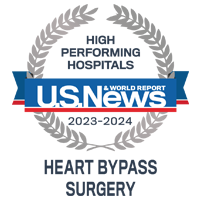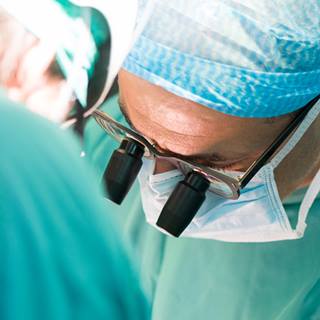Coronary Artery Disease

Overview
Coronary artery disease — also called coronary vascular, arteriosclerotic and ischemic heart disease — remains the leading cause of death in the United States. The disease is caused by arteriosclerosis or "hardening of the arteries," which interferes with the normal flow of blood to the heart. It affects the arteries that surround and supply blood to the heart, causing more than a half million deaths a year. When the heart doesn't receive enough blood, symptoms may include pain or pressure in the chest, arm or jaw. This is a warning sign that your heart is having difficulty. If left untreated, it can result in a heart attack.
Our approach to coronary artery disease
UCSF's cardiac specialists are leaders in preventing, diagnosing and treating coronary artery disease. We provide attentive, personalized care to people who may be at high risk, such as those with a family history of heart disease, high blood pressure or high cholesterol, as well as those nearing middle age and worried about a lifestyle that may have taken a toll on their heart.
Our screening tools include laboratory tests to measure fats and cholesterol in the blood, nonsurgical imaging technologies that give doctors a window on the heart's function, and stress tests that show how the heart responds to exertion. We also offer a full range of heart disease prevention and treatment options, from medications and nutritional counseling to minimally invasive procedures and traditional surgery.
Finally, UCSF has a rapid mobilization team on call 24 hours a day to respond when a patient suffers a heart attack. At UCSF's cardiac critical care unit, these patients receive comprehensive, specialized treatment from a team that includes doctors, nurses, social workers, nutritionists, pharmacists, pastoral care providers, physical therapists and respiratory therapists.
Awards & recognition
-

Among the top hospitals in the nation
-

One of the nation's best in cardiology and heart & vascular surgery
-

Rated high-performing hospital for heart bypass surgery
Signs & symptoms
The most common disease of the coronary arteries is arteriosclerosis, commonly called "hardening of the arteries." Plaque — a combination of cholesterol and other fats, calcium and other elements carried in the blood — builds up in the small blood vessels that feed the heart. When this condition exists in other parts of the body, it is called atherosclerosis.
This plaque buildup can, in time, narrow the arteries so severely that blood flow to the heart is inadequate and symptoms of insufficient blood flow — called angina — develop. Angina is a term meaning strangling or oppressive heaviness and pain, but it has become synonymous with angina pectoris or chest pain caused by lack of oxygen to the heart due to poor blood supply.
In addition to angina or chest pain, arteriosclerosis can produce fatigue, shortness of breath and an abnormal heart beat or arrhythmia. Plaque also can tear the artery walls and form blood clots that can lead to a heart attack. Often, there are no symptoms of arteriosclerosis until a heart attack occurs.
Diagnosis
Doctors know that some people are at high risk of this kind of heart disease because of certain physical and behavioral characteristics. For example, men generally are at greater risk for heart disease but the risk increases for women after menopause. Other characteristics for arteriosclerosis include:
- Age
- Diabetes
- Family history of heart disease
- High blood cholesterol
- High blood pressure
- Obesity
- Sedentary lifestyle
- Smoking
- Stress
Arteriosclerosis is diagnosed through various tests including:
- Coronary angiography. Coronary angiography, also called cardiac catheterization, is a minimally invasive study that is considered the gold standard for diagnosing coronary artery disease. This test is performed under local anesthesia and involves injecting X-ray dye or contrast medium into the coronary arteries via tubes called catheters. An X-ray camera films the blood flow to show the location and severity of artery narrowing. This test can show if the blood vessels in your heart have narrowed, your heart is pumping normally and blood is flowing correctly and your heart valves are functioning properly. It also can identify any heart abnormalities you may have been born with or congenital abnormalities.
- Echocardiogram (ECHO). This non-invasive test translates sound waves from your chest into pictures of your heart. It provides information about how the heart is pumping, how blood flows in the heart and blood vessels, how large the heart is and how the valves are working.
- Electrocardiogram (ECG or EKG). The electrocardiogram records the heart's electrical activity. Small patches called electrodes are placed on your chest, arms and legs, and are connected by wires to the ECG machine. Your heart's electrical impulses are translated into a wavy line on a strip of paper, enabling doctors to determine the pattern of electrical current flow in the heart and to diagnose arrhythmias and heart damage.
- Stress echocardiogram. Stress tests are performed to see how the heart performs under physical stress. The heart can be stressed with exercise on a treadmill or in a few instances, a bicycle. If you can't exercise on a treadmill or bicycle, medications can be used to cause the heart rate to increase, simulating normal reactions of the heart to exercise. During the stress test, you will wear ECG electrodes and wires while exercising so that the electrical signals of your heart can be recorded at the same time.
- Stress thallium test. Stress thallium tests have two components — a treadmill stress test and heart scan after injection of a radionuclide material, such as thallium, which allows doctors to see the coronary arteries and the shape and function of the heart. It has been used in this manner safely for many years to demonstrate the amount of blood the heart is getting under various conditions — rest and stress.
Treatments
Medications and sometimes lifestyle changes, such as quitting smoking or losing weight, can help improve heart efficiency to reduce angina but can't eliminate the plaque blockages. Medications may include cholesterol-lowering drugs, Beta-blockers, nitroglycerin, calcium channel blockers, angiotensin-converting enzyme inhibitors and others.
Plaque removal
To remove plaque from arteries, the following procedures are performed:
Angioplasty
Angioplasty, also called percutaneous transluminal coronary angioplasty or PTCA, involves inserting a long flexible tube called a catheter into a blood vessel through a small incision in your skin. The catheter has a deflated balloon on its tip. Once the catheter reaches the blocked blood vessel, the balloon is inflated and compresses the plaque against the sides of the blood vessel. The balloon may be inflated and deflated several times. Often, the procedure is done in conjunction with a small metal tube called a stent that is left in the artery to serve as a scaffold to keep the artery open and prevent the plaque from springing back toward the center of the vessel.
Coronary artery bypass graft
Coronary artery bypass graft (CABG) surgery is an operation in which an artery or a piece of vein taken from elsewhere in your body is attached to the blood vessel to detour blood around the blockage. Conventionally, this is done through open-heart surgery. The surgeon makes a large incision and cuts through the breastbone to access the heart; during part of the operation, your heart will be stopped and a heart-lung machine will be used to pump your blood and help you breathe. UCSF offers an alternative minimally invasive bypass surgery in which the surgeon accesses the heart through a small incision without having to cut bones. There's no need to stop your heart, and most patients don't have to be on a heart-lung bypass machine. The recovery time is 10 days to two weeks, compared to the three to four months it typically takes to recover from open-heart bypass surgery. CABG is the most successful and most common major heart surgery in the Western world.
Coronary stent
A coronary stent is a small, latticed, high-grade stainless steel tube that is used to hold the coronary artery open and minimize the chance of abrupt closure after angioplasty. It is placed in the coronary artery using the same procedure as the angioplasty. The stent is typically positioned at the narrowed area of the artery. When the catheter's balloon is inflated, the stent expands and is pressed against the vessel wall. The balloon is deflated and withdrawn, leaving the stent permanently in place. After a stent is placed, you will be prescribed an antiplatelet medication, Clopidogrel, also known as Plavix, for one month. This is used to minimize the risk of clot formation in the stent while tissue grows around the stent to incorporate it into the blood vessel wall. Within a month, the body no longer "sees" the stent, and the medication is no longer needed. You should continue to take aspirin, if it has been prescribed, along with the Clopidogrel.
Rotational atherectomy
Rotational atherectomy widens narrowed arteries using a high-speed rotational device to "sand" away plaque. This technique is used in particular situations, such as with plaque with large amounts of calcium or to widen blockages within a stent.
UCSF Health medical specialists have reviewed this information. It is for educational purposes only and is not intended to replace the advice of your doctor or other health care provider. We encourage you to discuss any questions or concerns you may have with your provider.


























